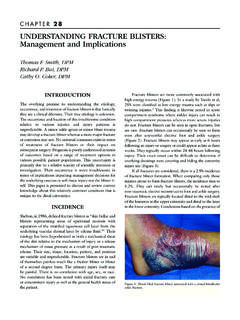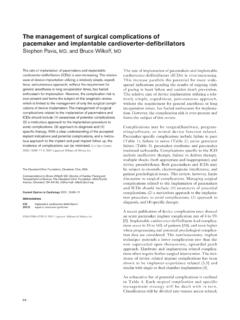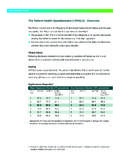Transcription of 1997 Physical Exam Bullets Coding Based on Time
1 Coding Based on Time 1997 Physical Exam Bullets Genitourinary (Female). *When Coding Based on TIME, you MUST spend the entire Examination of the external genitalia Constitutional allotted time face-to-face with the patient AND over half of Examination of the urethra that time must have been devoted to counseling and/or co- Three vital signs Examination of the bladder (fullness, masses, tenderness). ordination of care. Time spent must be documented. General appearance Examination of the cervix Eyes Examination of the uterus (size, contour, position, mobility). Examination of the adnexa (masses, tenderness, nodularity). Critical Care Services E/M Coding Guide Critical care is the direct delivery by a physician of medical Inspection of conjunctivae and lids Examination of pupils and irises (PERRLA). Lymphatic: Palpation of lymph nodes in two or more care for any critical illness which acutely impairs one or Rational Physician Coding Steps areas: more vital organ systems. Time spent on critical care ser- Ophthalmoscopic examination of discs and posterior segments Neck Groin 1.
2 Calculate Medical Decision-Making (MDM). vices must be documented. Add up time spent within each Ears, Nose, Mouth, and Throat Axillae Other ( , extremities) 2. Identify target E/M code supported by MDM. calendar date in the unit or discussing care issues with the 3. Confirm medical necessity of history/exam External appearance of the ears and nose designated surrogate decision-maker or other treating physi- Skin 4. Perform and document required elements Otoscopic exam of the external auditory canals and TMs cians. Time spent does NOT need to be continuous. Assessment of hearing Inspection of skin and subcutaneous tissue (rashes, lesions, Code 99291 for the first 30 minutes to 1 hour of critical care For clinically-driven E/M Coding education, Inspection of nasal mucosa, septum and turbinates ulcers) visit us at or call us Code 99292 for each additional 30 minutes of critical care Inspection of lips, teeth and gums Palpation of the skin and subcutaneous tissue (induration, subcutaneous nodules, tightening) A 30 minute threshold is required for the first hour of criti- at 1-888-U-EM-CODE.
3 Examination of oropharynx: oral mucosa, salivary glands, hard and soft palates, tongue, tonsils and posterior pharynx Musculoskeletal cal care. A 15 minute threshold is required for each suc- cessive half hour of critical care beyond the first hour. New Office Patients Neck Examination of gait and station Inspection and/or palpation of digits and nails (clubbing, cya- Prolonged Services MDM E/M Hx Exam Time*. Exam of neck (masses, symmetry, tracheal position, crepitus). nosis, ischemia) Prolonged services are billed separately when a physician SF 99201 PF PF 10. Examination of thyroid (masses, nodules, tenderness). Examination of the joints, bones, and muscles of one or more of spends over 30 minutes above and beyond the time allotted SF 99202 EPF EPF 20. Respiratory Low 99203 Det Det 30. the following six areas: for any E/M encounter. Time must be spent face-to-face Assessment of respiratory effort with the patient but does NOT need to continuous within Mod 99204 Comp Comp 45.
4 1) Head and neck 4) Left upper extremity Percussion of chest any calendar date. Time must be documented. These High 99205 Comp Comp 60. 2) Spine, ribs, and pelvis 5) Right lower extremity Palpation of chest (tactile fremitus) 3) Right upper extremity 6) Left lower extremity codes are reported in addition to standard E/M codes. Auscultation of the lungs Requires 3/3 key components Code 99354 for the first 30 minutes to one hour of pro- Chest (Breasts) The examination of a given area may include: longed services in the outpatient setting. Code 99355 for Established Office Patients Inspection of the breasts Inspection and/or palpation with notation of presence of any each additional 30 minutes beyond the first hour. MDM E/M Hx Exam Time*. Palpation of the breasts and axillae misalignment, asymmetry, crepitation, defects, tenderness, Code 99356 for the first 30 minutes to one hour of pro- None 99211 None None 5. Cardiovascular masses or effusions longed services in the inpatient setting.
5 Code 99357 for SF 99212 PF PF 10. Assessment of range of motion with notation of any pain, each additional 30 minutes beyond the first hour. Low 99213 EPF EPF 15. Palpation of the heart (PMI) crepitation or contracture Mod 99214 Det Det 25. Auscultation of the heart Assessment of stability with notation of any dislocation, sub- Observation/Observation & D/C. Assessment of lower extremity edema High 99215 Comp Comp 40. luxation, or laxity MDM E/M Hx Exam Time*. Examination of the carotid arteries Requires 2/3 key components Assessment of muscle strength and tone with notation of any SF/Low 99218/99234 Det Det NA. Examination of abdominal aorta atrophy or abnormal movements Mod 99219/99235 Comp Comp NA. Examination of the femoral pulses Admission H&Ps Examination of the pedal pulses Neurologic High 99220/99236 Comp Comp NA. MDM E/M Hx Exam Time*. Test cranial nerves with notation of any deficits Requires 3/3 key components Gastrointestinal (Abdomen) SF/Low 99221 Det Det 30.
6 Examination of DTRs with notation of abnormal reflexes Examination of the abdomen (masses or tenderness) Office (9924x) & Inpatient (9925x) Consults Mod 99222 Comp Comp 50. Examination of sensation (touch, pin-prick, vibration, proprio- Examination of the liver and spleen ception) MDM E/M Hx Exam Time* High 99223 Comp Comp 70. Examination for the presence or absence of hernias SF 99241/99251 PF PF 15/20 Requires 3/3 key components Examination of anus, perineum, and rectum Psychiatric SF 99242/99252 EPF EPF 30/40. Obtain stool for occult blood testing if indicated Description of patient's judgment and insight Hospital Progress Notes Low 99243/99253 Det Det 40/55. Genitourinary (Male) Mod 99244/99254 Comp Comp 60/80. MDM E/M Hx Exam Time*. Brief assessment of mental status, which may include: SF/Low 99231 PF PF 15. Examination of the scrotal contents (tenderness of cord, tes- Orientation to time, place, and person High 99245/99255 Comp Comp 80/110. ticular mass) Mod 99232 EPF EPF 25.
7 Recent and remote memory Requires 3/3 key components Examination of the penis CPT codes and descriptions are copyrighted to the American High 99233 Det Det 35. Mood and affect Digital rectal examination of the prostate Medical Association Requires 2/3 key components Table of Risk History History Tips Stratify risk Based on the presenting problems, diagnostic procedures or management options selected Comprehensive: 4 elements of HPI* or the status of 3 1) A chief complaint is required for every encounter. It may chronic medical problems**, 10 system ROS, and com- be a symptom or a statement such as follow-up HTN.. Minimal Risk Low Risk Moderate Risk High Risk plete PFSH (only 2/3 PFSH needed for office follow-up 2) The physician must always complete the HPI. However, and ER visits) it is acceptable to have the patient or a member of your One self-limited Two or more self-limited One or more chronic illness, with mild Chronic illness with severe Detailed: 4 elements of HPI* or the status of 3 chronic staff fill out a questionnaire for the past medical, family, or minor problem or minor problems exacerbation or progression exacerbation or progression and social history (PFSH).
8 However, to ensure credit for ( , cold, insect One stable chronic ill- Two or more stable chronic illnesses Illness with threat to life or medical problems**, 2 - 9 ROS, plus one pertinent PFSH. (PFSH NOT required for hospital progress notes) this information, you should initial the intake form and bite, tinea cor- ness, ( , well con- Undiagnosed new problem with uncer- bodily function (MI, ARF, PE) include any pertinent positive and negative items in the poris) trolled HTN, DM2) tain prognosis ( , lump in breast) Abrupt change in neurological Expanded Problem Focused: 1 - 3 elements of HPI* or body of your note. You should also mention that you Acute uncomplicated Acute illness with systemic symptoms status (TIA, weakness) status of 1 - 2 chronic medical problems**, plus 1 ROS reviewed the form in its entirety. Finally, you must keep Labs illness or injury ( , ( , pyelonephritis, colitis) the questionnaire as a permanent part of the medical Problem Focused: 1 - 3 elements of HPI* or status of record.)
9 EKG cystitis/rhinitis) Cardiovascular imaging with 1 2 chronic medical problems**. EEG Physiologic tests with stress contrast (arteriogram, cardiac 3) You don't have to list out the ROS; it is acceptable to CXR Physiologic tests without Endoscopy without known risk factors cath) with risk factors *HPI elements: location, quality, severity, duration, have the patient fill out a form and then initial it, but that UA stress Deep needle/incisional biopsy EP studies timing, context, modifying factors, associated signs or form must remain in the chart and you must refer to it in Ultrasound Non-cardiovascular im- Cardiovascular imaging with contrast Endoscopy with risk factors symptoms (use for '95 OR '97 E/M guidelines) the body of your note. For example, Complete 10 sys- Echo aging with contrast without risk factors (arteriogram/cath) Discography **For 1997 E/M guidelines only (NOT for '95 rules) tem ROS performed and documented, with pertinent KOH prep Skin or superficial needle Fluid from body cavity (LP, thoracen- findings included in the interval history.
10 Review of Systems biopsy tesis, paracentesis, etc.) Elective major surgery with Constitutional Eyes Ears/Nose/Throat Rest ABG risk factors 4) A Complete ROS requires that at least 10 systems be Cardiovascular Respiratory Gastrointestinal documented. Those systems with positive or pertinent Gargles Prescription drug management Emergency surgery Genitourinary Integumentary Musculoskeletal negative responses must be individually documented. Elastic bandages Over the counter drugs Minor surgery with risk factors Parenteral controlled sub- Psychiatric Endocrine Neurological For the remaining systems, a notation indicating all Superficial dress- Minor surgery without Elective major surgery without risk stances Hematologic/Lymphatic Allergic/Immunologic other systems are negative is permissible. (Warning: ings risk factors factors Drugs requiring intensive Some Medicare carriers do NOT accept this shortcut.). PT/OT. IV fluids without addi- IV fluids with additives Closed treatment of fracture or dislo- monitoring for toxicity Decision for DNR or to de- Physical Exam 5) When doing a comprehensive history on a follow-up tives cation escalate care 1995 Exam Rules patient in the office, you do not need to re-dictate a previous PFSH if one is already in the chart.







